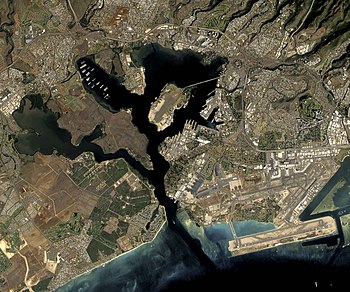Pearl Harbor (World War II): Difference between revisions
imported>Howard C. Berkowitz (Moved background to main WWII/Pac article) |
Pat Palmer (talk | contribs) mNo edit summary |
||
| (40 intermediate revisions by 5 users not shown) | |||
| Line 1: | Line 1: | ||
{{subpages}} | {{subpages}} | ||
{{ | {{Image|PearlHarbor Sm.jpg|right|350px|Pearl Harbor as seen from the air in 2000.}} | ||
'' | '''Pearl Harbor''', located in Honolulu, [[Hawaii (U.S. state)|Hawaii]] on the island of O'ahu, is a [[United States of America|U.S.]] naval base that, during '''[[World War II]]''', was the target of a devastating surprise attack by the [[Imperial Japanese Navy]] on December 7, 1941. This attack galvanized the American public, which until then had resisted entry into [[World War II]], to intervene in defense of the Allies. During the attack, a key ship lost was the Pennsylvania-class USS Arizona (BB-39); it exploded and sank from the air attack with the greatest loss of life at any point during the event. | ||
The Pearl Harbor commanders, Admiral [[Husband Kimmel]] (Navy) and [[lieutenant general|Lieutenant General]] [[Walter Short]] (Army), had no warning of the attack, during which 2,403 Americans were killed and 1,178 wounded. Eighteen U.S. ships were lost, including five battleships. By contrast, only 55 Japanese airmen and 9 submariners were killed (with 1 captured), with just 29 of the 350 Japanese planes that took part in the raid lost. | |||
==References== | |||
{{reflist|2}}[[Category:Suggestion Bot Tag]] | |||
== | |||
Latest revision as of 08:08, 24 October 2024
Pearl Harbor, located in Honolulu, Hawaii on the island of O'ahu, is a U.S. naval base that, during World War II, was the target of a devastating surprise attack by the Imperial Japanese Navy on December 7, 1941. This attack galvanized the American public, which until then had resisted entry into World War II, to intervene in defense of the Allies. During the attack, a key ship lost was the Pennsylvania-class USS Arizona (BB-39); it exploded and sank from the air attack with the greatest loss of life at any point during the event.
The Pearl Harbor commanders, Admiral Husband Kimmel (Navy) and Lieutenant General Walter Short (Army), had no warning of the attack, during which 2,403 Americans were killed and 1,178 wounded. Eighteen U.S. ships were lost, including five battleships. By contrast, only 55 Japanese airmen and 9 submariners were killed (with 1 captured), with just 29 of the 350 Japanese planes that took part in the raid lost.
